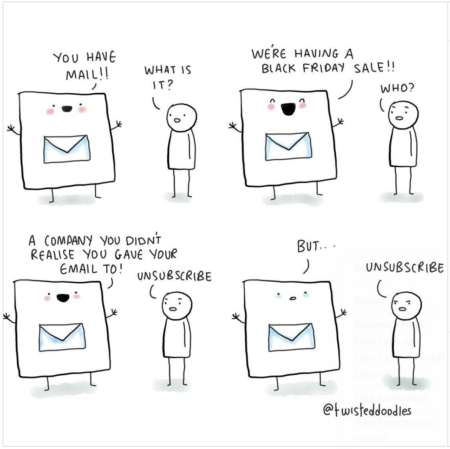About that cold email
- laura
- June 23, 2025
- Delivery improvement
Over the years I’ve made the decision to stop working with certain types of senders. Most recently it’s been the decision to not work with companies sending cold email. I even wrote a blog post back in 2018 about my frustration with clients who were upset their cold email was going to the spam folder. That was the beginning of the end for cold emailers as clients. I did continue to try and work with those senders, but they were incredibly frustrating engagements. I’d offer all my best practices, even try and work out how they could continue to use their purchased lists. They simply didn’t listen, they just didn’t want to hear that deliverability isn’t just about numbers and they couldn’t metric their way into the inbox. What they really wanted was me to tell them the One Weird Trick that would get their mail into the inbox.
Even more frustrating was people often came to me after making their way through other deliverability consultants many of whom claimed they actually had that One Weird Trick to get B2B cold email into the inbox. I ended up trying to clean up the mess the other consultants made both with the email program and with the client companies. I’d spend a lot of time just explaining the basics of deliverability and correcting their misunderstandings of email and delivery. Then I’d have to work to get any changes implemented. “But our other consultant said…” Yes, but you left them because your mail was going to spam, right? You can’t keep doing the same things that got you into the spam folder and expect to magically get to the inbox. It was just an exercise in frustration, for me and for the client. I finally decided there was no benefit to anyone for me to continue with these clients.
These days I’m getting a wave of new inquries for help from cold emailers and seeing a lot of discussion about delivery problems with cold email on various marketing forums. Mostly it’s complaining about how their mail was delivering fine and now, all of a sudden, it’s going to spam. What can they do? How can they fix it? It seems that the filters have caught up and are more aggressively filtering cold email to the spam folder. None of this is really surprising. I, and many of my deliverability colleagues, have been warning folks that the filters were going to catch up. I’m sure that the cold email deliverability specialists are working on the next bit of magic to evade filters, but until then those of us subjected to cold email are getting a bit of a reprieve.
There does seem to be a shift in how filtering companies are looking at cold email. I know in the past they were somewhat ambivalent about blocking it, back when it wasn’t sent in such volume and there was at least a small pretense of targeting. These days, though, cold email is being sent in significant volume. Last week Spamhaus even weighed in and published a statement on their blog related to cold email, and they made their position clear from the title: Spamhaus’ take on Cold Emailing… AKA spam.
A growing number of businesses use email scrapers, warm-up tools, fake engagement services, and cousin domains, all under the guise of legitimate outreach.
These messages are highly irrelevant with the same templates being duplicated and sent at scale with no intention of defining legitimate business interest. Scraping tools are particularly useful for extracting decision makers from business networking platforms or to auto-complete email addresses based on Personally Identifiable Information (PII).
I’m pleased Spamhaus has taken a public stance on Cold Email. All cold emailers should realize that cold email as it’s currently being sent is vulnerable to all the consequences of spam, including a Spamhaus listing. I want to publicly thank Spamhaus for stepping up and making a public statement about this kind of mail.
The irony is most B2B mailers are convinced that since their complaint rates are zero and their bounce rates are low and even their open rates are OK that there is no reason for their mail to be blocked. I’ve said over and over again: it’s not the metrics that make for a good reputation. Reputation is about people, not numbers.
The “ideal” numbers for B2B mail are readily explained.
- List hygiene services remove any bounces before the list is mailed.
- Opens are actually pre-fetches or spam filtering appliances fetching all images before delivery
- Complaints are zero because FBLs don’t exist in the B2B space.
The whole B2B deliverability industry is set up to make the metrics look good, but those metrics are fundamentally misleading and don’t reflect the quality or wantedness of emails. The filters don’t rely on sender metrics, they look at recipient reactions. Those filters have now caught up and are filtering B2B cold email more and more. They’ve caught up with the filter busting techniques that the cold email experts recommend. Senders who’ve seen success with the One Weird Trick are now shocked that the hashbusters and rotating domains and shared sending IPs are not longer enough to get out of spam.
To which I say: Good. B2B cold email is spam and should be blocked by spam filters.
 Read More
Read More